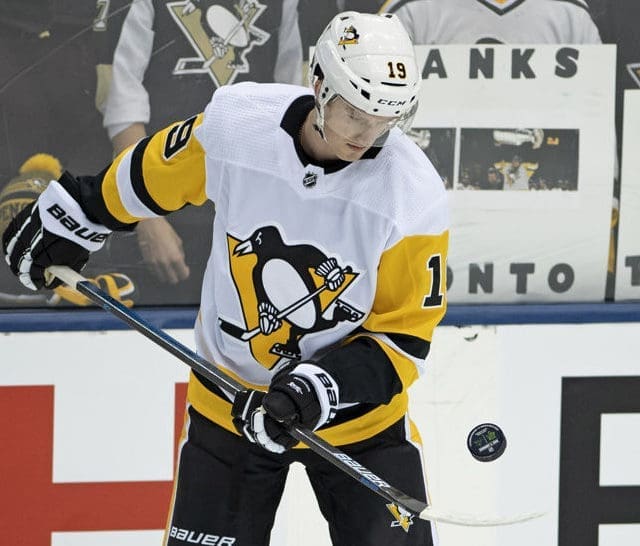Penguins
Moving From C To LW On Third Line Could Benefit McCann

Anyone who has followed the Pittsburgh Penguins the past season-plus knows that Jared McCann is a versatile fellow with speed, energy, an above-average shot and the ability to adapt to any forward spot.
Maybe not just a forward spot.
“I’m always prepared, whether it’s center or wing,” McCann said Monday. “Haven’t played much ‘D,’ but if I have to I’ll give it a shot. Whatever they ask me, I’m going to try to bring as much speed and as much intensity to the game as I can.”
So, if injuries or COVID-19 ravage the Penguins lineup, could we hear this announcement: At left defense, Jared McCann?
Um, not likely.
McCann knows that, of course. He was just making a point. We think. Probably.
For now – and now is a short-term proposition with the 2020-21 season starting Wednesday at Philadelphia – McCann is penciled in on the left side of the third line. Newcomer Mark Jankowski has been centering that line in training camp, and lately Brandon Tanev has manned the right wing.
The Penguins have been trying to develop an established third line behind the Sidney Crosby and Evgeni Maklin lines for the past few seasons, and coach Mike Sullivan offered a definition of what he’s searching for this season.
“We would like that line to be a good 200-foot line for us,” Sullivan said. “They’re a line that has the potential to chip in and help us offensively by scoring goals, but they’re also a line that should be hard to play against, that we can play against anybody’s top player, that can get defensive zone starts, that can defend hard for us.”
Fine by McCann.
He called Jankowski “a very skilled player. He’s a big guy, does a lot of work in the corners. I think he really complements me and (Tanev) very well,” and noted Tanev’s speed as being an asset to the third line.
“We can be a line that is not only good defensively, but we can contribute (offensively),” he said. “Some nights the top two lines just don’t have it and we’ve got to be that difference-maker, that line that can chip in, but we’ve also got to remember that it’s about the (defensive) zone first.”
McCann, 24, spent a good amount of last season centering the third line. Not because that’s his ideal spot; he seems more suited to the wing in spite of his versatility. But injuries, particularly to then-Penguins center Nick Bjugstad, meant the Penguins played him at that center spot out of necessity.
Whether it’s a coincidence that McCann had no goals over the final 22 games before the pandemic shut down the NHL season is purely conjecture.
Although he had 14 goals, 35 points in 66 games, his offensive production seemed to lag behind the potential of someone with a commanding shot such as McCann has.
“I wasn’t getting many bounces. Pucks were bouncing over my stick, or goalies were making good saves,” McCann said. “I’m not going to dwell on it. I’m just going to move forward from it. It happened. It’s in the past.
“I feel like this season I’m not focused on points or anything like that at all. I’m just going to try to contribute to the team, whether it’s offensively or defensively.”
Still, he spent some of the unconventional offseason working with video/skills coach Joey Hishon in his native Stratford, Ontario.
“It’s something we’ve looked at,” McCann said of evaluating his shot and when to let it loose. “I feel like there’s not really such thing as a bad shot. Every shot has a chance to go in. I’m not going to force it, try to shoot through legs – I’m not going to try to do all that stuff. I’m going to try to read the play, and if my teammates are open I’m going to try to find them. If the shot’s there, though, I’m 100 percent going to take it.”












